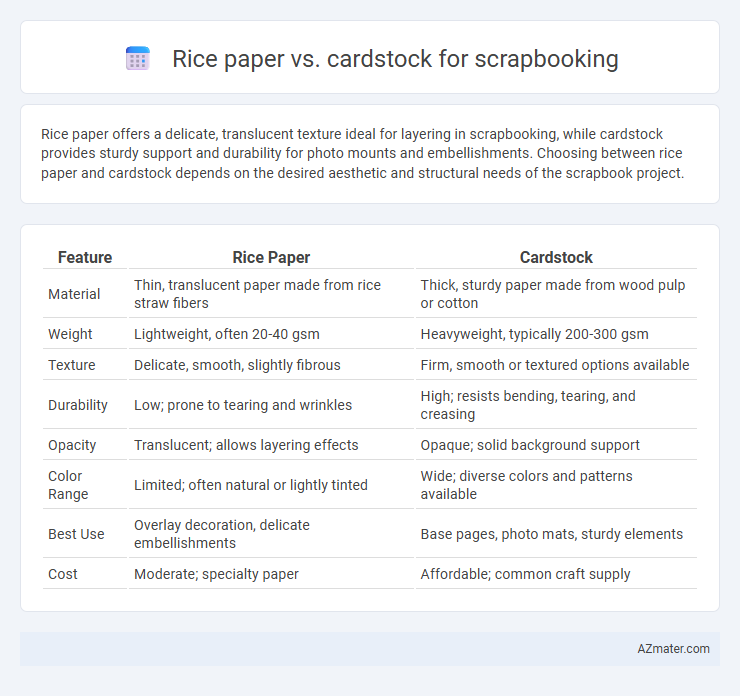Rice paper offers a delicate, translucent texture ideal for layering in scrapbooking, while cardstock provides sturdy support and durability for photo mounts and embellishments. Choosing between rice paper and cardstock depends on the desired aesthetic and structural needs of the scrapbook project.
Table of Comparison
| Feature | Rice Paper | Cardstock |
|---|---|---|
| Material | Thin, translucent paper made from rice straw fibers | Thick, sturdy paper made from wood pulp or cotton |
| Weight | Lightweight, often 20-40 gsm | Heavyweight, typically 200-300 gsm |
| Texture | Delicate, smooth, slightly fibrous | Firm, smooth or textured options available |
| Durability | Low; prone to tearing and wrinkles | High; resists bending, tearing, and creasing |
| Opacity | Translucent; allows layering effects | Opaque; solid background support |
| Color Range | Limited; often natural or lightly tinted | Wide; diverse colors and patterns available |
| Best Use | Overlay decoration, delicate embellishments | Base pages, photo mats, sturdy elements |
| Cost | Moderate; specialty paper | Affordable; common craft supply |
Introduction to Rice Paper and Cardstock
Rice paper, made from the pith of the rice plant, offers a delicate, translucent texture ideal for layering and intricate scrapbooking designs, while cardstock, thicker and sturdier, provides a durable base essential for supporting heavier embellishments and photos. Rice paper's lightweight nature allows for easy manipulation and a unique, organic aesthetic, contrasting with cardstock's rigidity that enhances structural stability and longevity in scrapbook pages. Selecting between rice paper and cardstock depends on the desired texture, weight, and durability for your scrapbooking project.
Material Composition: Rice Paper vs Cardstock
Rice paper for scrapbooking is made from the pith of the rice plant, resulting in an ultra-thin, lightweight, and translucent material that offers delicate textures and intricate designs. Cardstock, composed primarily of thick, high-quality paper fibers often reinforced with cotton or wood pulp, provides a durable and sturdy surface ideal for layering and embellishments. The contrasting material compositions influence flexibility, opacity, and resilience, making rice paper suitable for subtle decorative elements while cardstock supports structural scrapbook components.
Texture and Appearance Comparison
Rice paper in scrapbooking offers a delicate, translucent texture that adds an ethereal, vintage look, making it ideal for layering and creating soft, feathered edges. Cardstock provides a sturdy, thick surface with a smooth or slightly textured finish, available in a wide range of colors and patterns, which supports robust embellishments and durability. The contrast between rice paper's fragile, lightweight feel and cardstock's solid, substantial presence allows crafters to choose materials based on the desired visual depth and tactile experience.
Durability and Longevity in Scrapbooking
Cardstock offers superior durability and longevity compared to rice paper, making it the preferred choice for scrapbooking projects intended to last. The thicker, sturdier texture of cardstock resists tearing, warping, and fading over time, ensuring photos and embellishments remain securely attached. Rice paper, while delicate and lightweight, is better suited for decorative layering but requires careful handling to maintain its integrity in long-term scrapbooks.
Versatility for Scrapbooking Techniques
Rice paper offers exceptional versatility for scrapbooking techniques due to its lightweight and translucent qualities, enabling layering, stamping, and intricate cutouts that add depth and texture to designs. Cardstock provides a sturdy, durable base ideal for structural elements like photo mats, embellishments, and dimensional effects, supporting a wide range of adhesives and inks without warping. Combining rice paper's delicate flexibility with cardstock's robustness enhances creative possibilities and allows scrapbookers to experiment with mixed media, embossing, and other advanced techniques.
Adhesives and Compatibility
Rice paper's delicate texture requires low-tack adhesives like glue sticks or double-sided tape to prevent wrinkling and tearing, making it less compatible with heavy or wet adhesives commonly used with cardstock. Cardstock's sturdy, thick surface can handle a variety of adhesives, including liquid glue, glue dots, and tape runners, ensuring strong adhesion for embellishments and layered designs. Compatibility differences mean scrapbookers should select adhesives based on the paper type to achieve optimal durability and aesthetic results.
Printing and Inking Results
Rice paper offers a delicate texture but tends to absorb ink quickly, which can cause colors to appear muted and details less sharp when printed or inked. Cardstock provides a sturdier surface with minimal ink absorption, resulting in vibrant colors and crisp lines that enhance the overall quality of scrapbook designs. For projects requiring high-definition prints or bold illustrations, cardstock is typically the preferred choice due to its superior ink retention and durability.
Weight and Thickness Differences
Rice paper is significantly lighter and thinner than cardstock, typically weighing around 20-30 gsm compared to cardstock's 200-300 gsm. The thin, translucent texture of rice paper provides a delicate, fragile feel ideal for layering and intricate designs, while cardstock offers durability and rigidity suitable for structural elements in scrapbooking. Weight and thickness differences directly impact handling, with cardstock providing more stability and rice paper allowing for subtle visual effects.
Cost Considerations for Scrapbookers
Rice paper offers a budget-friendly option for scrapbookers, typically costing significantly less per sheet compared to cardstock, making it ideal for large projects or frequent crafting. Cardstock, while more expensive, provides durability and a premium feel that can justify its higher price for special pages or embellishments. Balancing cost with quality needs helps scrapbookers maximize their creative potential without overspending.
Which to Choose: Rice Paper or Cardstock?
Rice paper offers a delicate, translucent texture ideal for layering and adding vintage effects in scrapbooking, enhancing visual depth without bulk. Cardstock provides a sturdy, durable base perfect for structural elements and supports heavier embellishments, ensuring long-lasting scrapbook pages. Choose rice paper for decorative accents requiring subtlety, and cardstock for foundational pieces demanding strength and stability.

Infographic: Rice paper vs Cardstock for Scrapbooking
 azmater.com
azmater.com